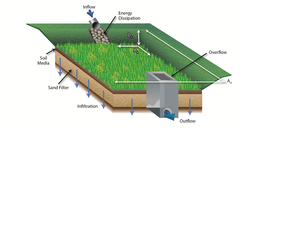
Difference between revisions of "Calculating credits for infiltration basin"
| Line 7: | Line 7: | ||
An Infiltration Basin is a large earthen structure designed to capture, store, and infiltrate stormwater water runoff. Infiltration basins rely on naturally permeable soils to fully infiltrate the designed water quality volume. Infiltration basins are typically off-line practices utilizing an emergency spillway or outlet structure to capture the volume of stormwater runoff for which the basin is designed. Volumes that exceed the rate or volume of the infiltration basin are allowed to bypass the BMP. | An Infiltration Basin is a large earthen structure designed to capture, store, and infiltrate stormwater water runoff. Infiltration basins rely on naturally permeable soils to fully infiltrate the designed water quality volume. Infiltration basins are typically off-line practices utilizing an emergency spillway or outlet structure to capture the volume of stormwater runoff for which the basin is designed. Volumes that exceed the rate or volume of the infiltration basin are allowed to bypass the BMP. | ||
| + | |||
| + | |||
| + | ===Pollutant Removal Mechanisms=== | ||
| + | |||
| + | Infiltration basins reduce stormwater volume and pollutant loads through infiltration of the stormwater runoff into the native soil. Infiltration basins also can remove a wide variety of stormwater pollutants through secondary removal mechanisms including filtration, biological uptake, and soil adsorption through plantings and soil media (WEF Design of Urban Stormwater Controls, 2012). See Section 3, Other Pollutants, for a complete list of other pollutants addressed by infiltration basins. | ||
| + | |||
| + | ===Location in the Treatment Train=== | ||
| + | |||
| + | Stormwater Treatment Trains are comprised of multiple Best Management Practices that work together to minimize the volume of stormwater runoff, remove pollutants, and reduce the rate of stormwater runoff being discharged to Minnesota wetlands, lakes and streams. Under the Treatment Train approach, stormwater management begins with simple methods that prevent pollution from accumulating on the land surface, followed by methods that minimize the volume of runoff generated and is followed by Best Management Practices that reduce the pollutant concentration and/or volume of stormwater runoff. Because Infiltration basins are designed to be off-line, they may either be located at the end of the treatment train, or used as off-line configurations to divert the water quality volume from the on-line system. | ||
Revision as of 15:47, 13 March 2015
This site is under construction. Anticipated completion date is April, 2015.
Overview
An Infiltration Basin is a large earthen structure designed to capture, store, and infiltrate stormwater water runoff. Infiltration basins rely on naturally permeable soils to fully infiltrate the designed water quality volume. Infiltration basins are typically off-line practices utilizing an emergency spillway or outlet structure to capture the volume of stormwater runoff for which the basin is designed. Volumes that exceed the rate or volume of the infiltration basin are allowed to bypass the BMP.
Pollutant Removal Mechanisms
Infiltration basins reduce stormwater volume and pollutant loads through infiltration of the stormwater runoff into the native soil. Infiltration basins also can remove a wide variety of stormwater pollutants through secondary removal mechanisms including filtration, biological uptake, and soil adsorption through plantings and soil media (WEF Design of Urban Stormwater Controls, 2012). See Section 3, Other Pollutants, for a complete list of other pollutants addressed by infiltration basins.
Location in the Treatment Train
Stormwater Treatment Trains are comprised of multiple Best Management Practices that work together to minimize the volume of stormwater runoff, remove pollutants, and reduce the rate of stormwater runoff being discharged to Minnesota wetlands, lakes and streams. Under the Treatment Train approach, stormwater management begins with simple methods that prevent pollution from accumulating on the land surface, followed by methods that minimize the volume of runoff generated and is followed by Best Management Practices that reduce the pollutant concentration and/or volume of stormwater runoff. Because Infiltration basins are designed to be off-line, they may either be located at the end of the treatment train, or used as off-line configurations to divert the water quality volume from the on-line system.
